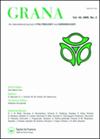Phylogenetic relationships among Pisum L. species from Asia Minor inferred from pollen and seed coat morphology
IF 1
4区 生物学
Q4 PLANT SCIENCES
引用次数: 1
Abstract
Abstract Morphological data from light microscopy (LM) and scanning electron microscopy (SEM) of pollen and seeds are used to explore phylogenetic relationships between four taxa of cultivated and wild Pisum including P. sativum subsp. sativum var. sativum and var. arvense, P. sativum subsp. elatius and P. fulvum. Characteristics investigated include pollen shapes and ornamentation, polar axis (P) and equatorial diameter (E), P/E ratio, exine thickness (Ex) and intine thickness (In), lumina diameter (L), muri thickness (M) and seed coat ornamentations in three accessions each of the four taxa. Pollen of Pisum is subprolate, reticulate and tricolporate. Ratios of P/E of the cultivated peas are higher than those of the wild species while diameter of lumina in the cultivated peas is smaller than that of the wild species. The cultivated pea has a smooth seed coat, in contrast to the rough surface of the wild species. The results of SEM micrographs reveal that seed coat ornamentation in each four-taxon set is typical papillose with thicker ribs than in the wild specimens. Differences in corolla colour, even among the five petals, are also noted for the taxa studied. The results suggest that pollen shapes and ornamentation are of limited taxonomic significance, while the seed coat ornamentation may be important for distinguishing taxa of Pisum.从花粉和种皮形态推断小亚细亚豌豆属植物的系统发育关系
摘要利用花粉和种子的光学显微镜(LM)和扫描电子显微镜(SEM)形态学数据,探讨了栽培和野生豌豆的四个分类群之间的系统发育关系。sativum变种sativum和var.avense,P.sativum亚种。elatius和P.fulvum。研究的特征包括花粉形状和纹饰、极轴(P)和赤道直径(E)、P/E比、外壁厚度(Ex)和内壁厚度(In)、管腔直径(L)、绒毛厚度(M)和种皮纹饰。雌蕊花粉为近板状,网状和三孔状。栽培豌豆的P/E比值高于野生豌豆,而栽培豌豆的管腔直径小于野生豌豆。栽培豌豆的种皮光滑,与野生豌豆的粗糙表面形成鲜明对比。SEM显微照片显示,每四个分类单元的种皮纹饰都是典型的乳头状突起,肋骨比野生标本厚。研究的分类群也注意到了花冠颜色的差异,甚至在五片花瓣之间也是如此。结果表明,花粉的形状和纹饰在分类学上的意义有限,而种皮的纹饰可能对区分豌豆属的分类群很重要。
本文章由计算机程序翻译,如有差异,请以英文原文为准。
求助全文
约1分钟内获得全文
求助全文
来源期刊

Grana
生物-植物科学
CiteScore
2.10
自引率
11.10%
发文量
23
审稿时长
>12 weeks
期刊介绍:
Grana is an international journal of palynology and aerobiology. It is published under the auspices of the Scandinavian Palynological Collegium (CPS) in affiliation with the International Association for Aerobiology (IAA). Grana publishes original papers, mainly on ontogony (morphology, and ultrastructure of pollen grains and spores of Eucaryota and their importance for plant taxonomy, ecology, phytogeography, paleobotany, etc.) and aerobiology. All submitted manuscripts are subject to initial appraisal by the Editors, and, if found suitable for further consideration, to peer review by independent, anonymous expert referees. All peer review is single blind and submission is online via ScholarOne Manuscripts.
 求助内容:
求助内容: 应助结果提醒方式:
应助结果提醒方式:


